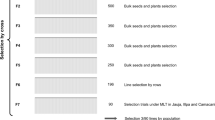Abstract
Developmental patterns were studied in five groups of quinoa lines from different maturity classes in three years, and measured on five occasions between bud formation and seed set. Knowledge of how the developmental stage develops through the growing season is of importance in the breeding and selection of quinoa lines. Ranking of lines for earliness was consistent over growing seasons, and therefore it was concluded that selection for earliness could be performed at an early stage, i.e. the beginning of July. A growing period greater than 150 days would normally be regarded as too long and risky in Northern Europe, but in the three years under investigation it was possible to harvest lines of the green type with a longer growing period. The total growing period for the lines tested ranged from 109 to 182 days. The vegetative phase and the total growth period were significantly longer for green types than seed types in all years. Duration of the seed set period differed between seed and green types, and between years. In the spring and early summer of the drought year, 1992, both vegetative and seed set periods were shorter than for the other years. It must be concluded that seed types originating from Chile were adapted for growth under North European conditions. Although seed harvest of green types can occur in Denmark, they should preferably be grown at a more southerly latitude.
Similar content being viewed by others
References
Barahona, E.T., 1975. Efecto del distanciamiento, densidad de siembra y variedades en el cultivo de la quinua. Tesis Ing Agro, Universidad Nacional Técnica del Altiplano, Puno, Peru.
Flores, F.G., 1977. Estudio preliminar de la fenología de la quinua (Chenopodium quinoa Willd.). Tesis, Universidad Nacional Técnica del Altiplano, Puno, Peru.
Gandarillas, H., 1979. Mejoramiento genetico. In: M. Tápia, H. Gandarillas, S. Alandia, A. Cardozo, A. Mujica, R. Ortiz, V. Otazu, J. Rea, B. Salas & E. Zanabria (eds), Quinoa y Kañiwa, pp. 65–82. CIID/IICA.
Jacobsen, S.-E., 1993. Quinoa (Chenopodium quinoa Willd.) — A novel crop for European agriculture. Ph D Thesis, Dep. of Agricultural Science, The Royal Veterinary and Agricultural University, Copenhagen, 145 pp.
Jacobsen, S.-E. & O. Stølen, 1993. Quinoa — Morphology and phenology and prospects for its production as a new crop in Europe. Eur J Agron 2: 19–29.
Jacobsen, S.-E., J. Hill & O. Stølen, 1996. Stability of quantitative traits in quinoa (Chenopodium quinoa). Accepted for publication in TAG.
Jacobsen, S.-E., I. Jørgensen & O. Stølen, 1994. Cultivation of quinoa (Chenopodium quinoa) under temperate climatic conditions in Denmark. J Agric Sci, Camb 122: 47–52.
Rea, J., 1948. Observaciones sobre biología floral y estudio de saponinas en Chenopodium quinoa Willd. Serie técnica 3, 17 pp.
Risi, C., J. & N.W. Galwey, 1989. The pattern of genetic diversity in the Andean grain crop quinoa (Chenopodium quinoa Willd.). I. Associations between characteristics. Euphytica 41: 147–162.
Author information
Authors and Affiliations
Rights and permissions
About this article
Cite this article
Jacobsen, SE. Adaptation of quinoa (Chenopodium quinoa) to Northern European agriculture: studies on developmental pattern. Euphytica 96, 41–48 (1997). https://doi.org/10.1023/A:1002992718009
Issue Date:
DOI: https://doi.org/10.1023/A:1002992718009




